Featured Photo Above:
Combined 1903 World Series Photo: Pittsburgh Pirates and Boston Pilgrims
(Color Restoration by Chris Whitehouse of Mancave Pictures)
Baseball History Comes Alive Now Ranked As a Top Five Website by Feedspot Among All Baseball History Websites and Blogs!
(Check out Feedspot's list of the Top 35 Baseball History websites and blogs)

Guest Submissions from Our Readers Always Welcome! Click for details
Scroll Down to Read Today’s Essay
Subscribe to Baseball History Comes Alive for automatic updates. As a Free Bonus, you’ll get instant access to my Special Report: Gary’s Handy Dandy World Series Reference Guide!
1955 World Series Photo Gallery
Click on any image below to see photos in full size and to start Photo Gallery:
We’ve finally reached the culmination of Michael Keedy’s Top Ten Greatest World Series Catches. It’s not a big surprise that Sandy Amoros’s game-saving catch in the 1955 World Series rates as his Number One. Not only was it a great catch, but it also helped save the Dodgers’ one and only World Series title while in Brooklyn. Be sure to check out the film clip below.
What constitutes a great catch is very subjective and we all have our own opinions. But I think we can all agree that Sandy’s catch was a great one. We’ve all had a lot of fun with this, and whether or not we agree or disagree with Michael’s selections or his rankings, we thank him for his efforts in this very entertaining series! –GL
Michael Keedy’s Top Ten Greatest World Series Catches!
Number One:
Sandy Amoros and the 1955 World Series
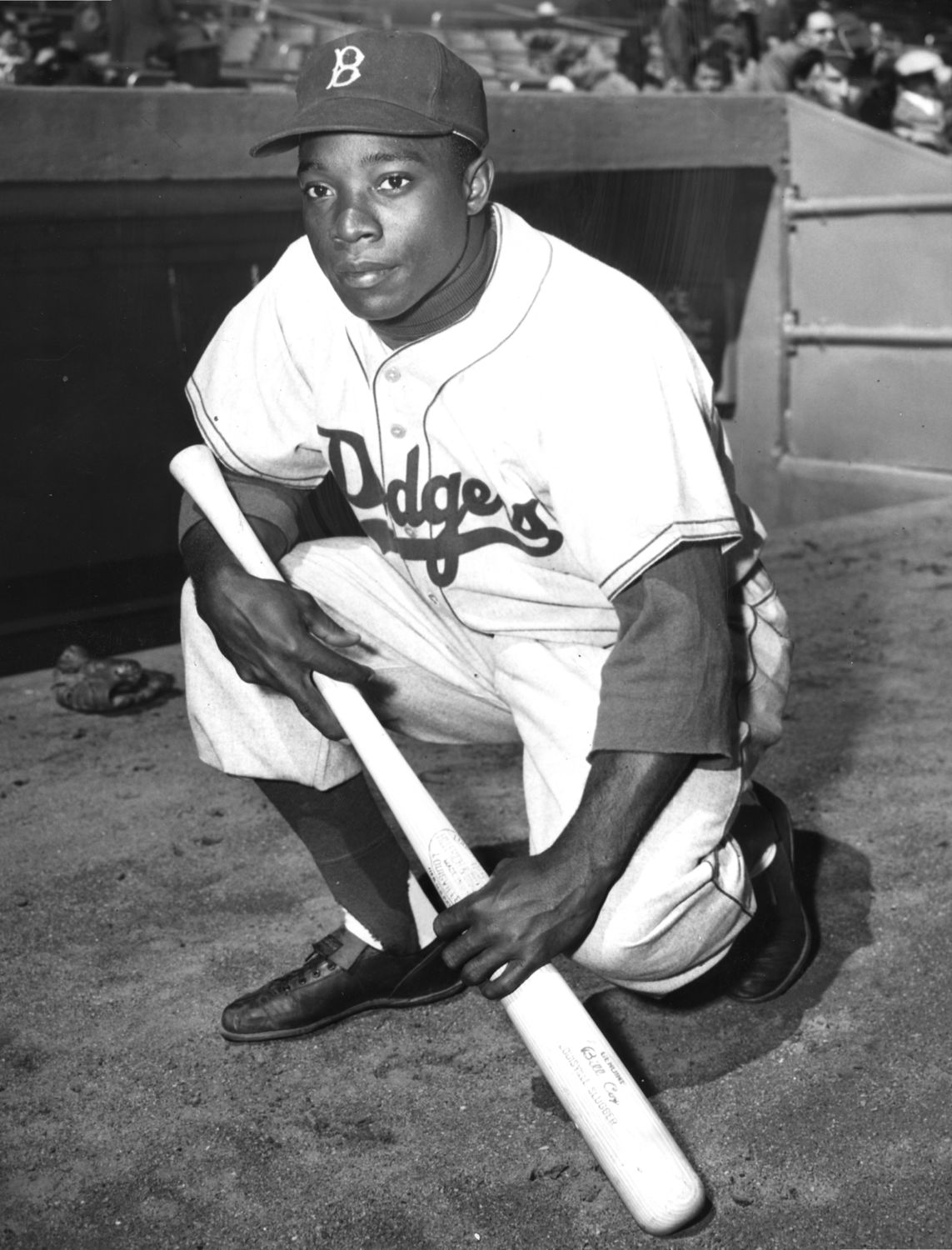
Long before the Dallas Cowboys came to be known as “America’s Team,” the Brooklyn Dodgers won the loving and sympathetic hearts of baseball fans across the country. Brokers, bankers, and sundry corporate executives sporting pinstripes and starched shirts might root for General Motors, IBM and the New York Yankees, but the steelworkers, cooks, carpenters, and mechanics who helped lay the cornerstones of a great nation lived and died with their beloved, “blue-collar” Bums, win or lose. The Dodgers were as human, accessible, inspiring, and exasperating as the Yanks were distant, domineering, mechanical, and monotonously triumphant.
“Next Year Is Finally Here!”
“Wait til next year!” was the fabled mantra for Brooklyn in the post-war. This team, blessed with a rich abundance of potential and promise, was at once the most storied and star-crossed of all big league franchises in the 1940s and ’50s. Well before the tardy arrival of Lady Luck in 1955, its familiar, annual rallying cry had become something of a cruel hoax. By the time their perennial tormentors from the Bronx had counted up the winners’ shares yet again, in ’53, the Dodgers were one of only three clubs remaining in the majors, along with the chronically inept Browns and routinely mediocre Phillies, never to have won a World Series.
They lost in 1916 to the Red Sox of Babe Ruth, who set an all-time record by pitching his team to a 14-inning, 2-1 win; and again in 1920, against Cleveland, which whipped up on them with the only unassisted triple play in series history, the first grand-slam in any Fall Classic, and the first postseason home run by a pitcher. Their next serious bid for a championship, in 1941, was the beginning of a long and demoralizing accumulation of near-misses, shattered dreams, and unanswered prayers.
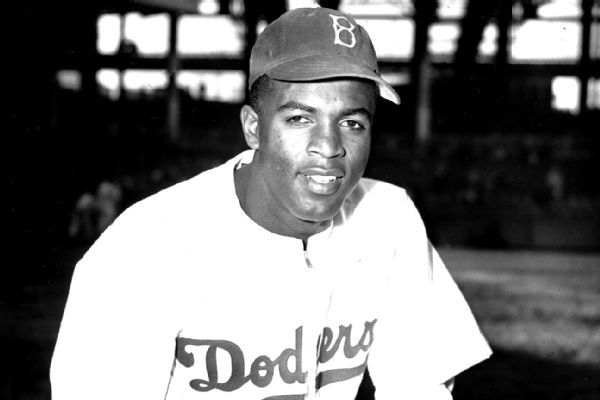
By spring training in 1955, the Dodgers were a rapidly-aging, anxious squad of skilled but imperfect might-have-beens. Father Time was gaining ground in giant strides on this, the oldest team in the majors. The litany of blown chances in 1941, ’42, ’46, ’47, ’49-50-51-2 and ’53 weighed heavily on the mind and shoulders of Jackie Robinson, by now a grey and declining 36, and Captain Pee Wee Reese, whose 37th birthday was coming right up. Since 1940, Reese had been on the field in every inning of every ill-fated game in which his team was chased down and overtaken from behind while within tantalizing reach of the promised land.
But the Boys of Summer, seemingly motivated by a now-or-never mentality, left baseball’s record books in tatters when they broke from the gate this year. They won their first ten games. Two weeks later, they were 22-and-2, with each loss coming by a single run. They clinched their eighth pennant on September 8, the earliest date in history. They became the first wire-to-wire team in the big leagues since the fearsome Murderers’ Row—who else?—claimed that distinction in 1927.
Another Subway Series opened at the Stadium in late September, the sixth such matchup in nine years. Battling to a 3-3 standoff, these familiar rivals headed for a classic and unforgettable finale on October 4, back in the Bronx. Could this be “next year”?
The Decisive Seventh Game!
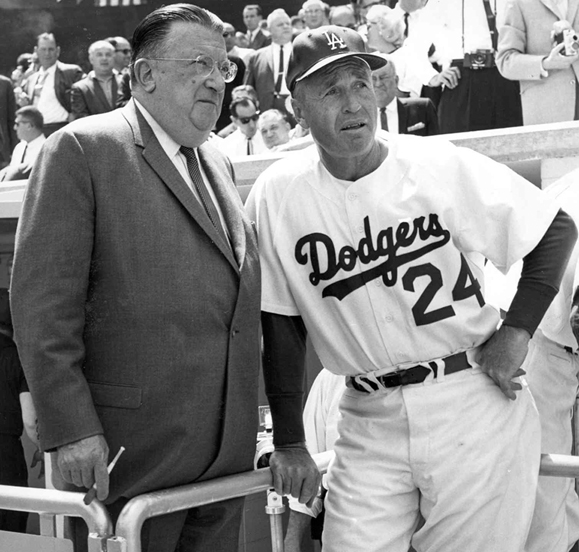
By the top of the sixth, Brooklyn’s slender 2-0 lead had been in constant jeopardy. When George Shuba pinch-hit for Don Zimmer, Manager Walt Alston had to rearrange his defense heading into the home half of the inning. Nobody knew it then, but the world was seeing baseball history in the making. A fateful die, without which New York would surely walk away with its record 17th championship, had now been cast. The right-handed Jim Gilliam took Zimmer’s spot in the infield, and Sandy Amoros, a southpaw, replaced Gilliam in left.
The bottom of the sixth quickly produced possibly the most tense, dramatic, and eventful moment in World Series play. With two on, nobody out, and the Yankees trailing, 2-0, Yogi Berra came to the plate. A left-hand power hitter, the three-time MVP was notorious for pulling the ball. A long bomb here, presumably to right, would sink the Dodgers. Knowing all this, and following instructions, Amoros moved to within a few yards of dead center, about halfway between the fence and the infield. He was standing sixty yards off the foul line in left when Johnny Podres threw his best fastball, low and away.
The Cuban Comet Comes Through!
Contrary to the expectations of 62,465 ticket-holders and the entire borough of Brooklyn, Berra punched the ball high into the air, toward the line in left. Billy Martin, carrying the Yanks’ first run, headed for third base. Gil McDougald, representing the tying run, sprinted at top speed toward second. He could see the play in the outfield perfectly as it developed in front of him. The rookie-of-the-year in 1951 and a most competent student of the game, McDougald was certain there was no way a mortal being could dream of outrunning this ball. It headed toward the line, nearing the 301-foot marker, with Amoros racing across miles of open pasture in hot and seemingly hopeless pursuit.
But Sandy Amoros wasn’t known as “The Cuban Comet” for nothing, or for the mere purpose of alliteration. Easily the fastest player on his team, he would later say, “I don’t know I get it. I just run like hell and stick out my glove.” He did that exactly, at the end of a long and speedy dash toward the distant foul line. In one spectacular moment, he was Jesse Owens in baseball cleats. The glove he mentioned was on his right hand. Thanks to blinding speed Gilliam didn’t possess, and a lefty’s maneuver Gilliam could not have made, the ball dropped out of the sky and into The Comet’s welcoming mitt.
A huge crowd stood stunned, and McDougald, on his way to third, was hung out to dry. With a perfect pirouette that only a lefthander could perform, Amoros fired a strike to Reese, yelling for the ball on the edge of the grass. The captain’s slingshot over to Gil Hodges, straining forward at first as an airborne McDougald started his desperate slide for the bag, completed a breathtaking, game-saving double play for these Boys from Brooklyn. The mighty Bombers’ ominous rally was suddenly over.
Surviving additional jittery moments in the seventh and eighthth, the Dodgers held on tight to win, 2-0. They were in the visitors’ clubhouse, celebrating Brooklyn’s one-and-only world championship, when Yogi Berra and his incredulous, appreciative manager raced over to congratulate their extraordinary outfielder on what is—in my humble opinion—the greatest defensive play in series history!
Michael H. Keedy
Subscribe to our website, “Baseball History Comes Alive!” with over 1200 fully categorized baseball essays and photo galleries, now closing in on the one million hits mark with 906K hits and over 700 subscribers: www.baseballhistorycomesalive.com
Information: Thomas Oliphant’s 2005 autobiography: “Praying For Gil Hodges.”
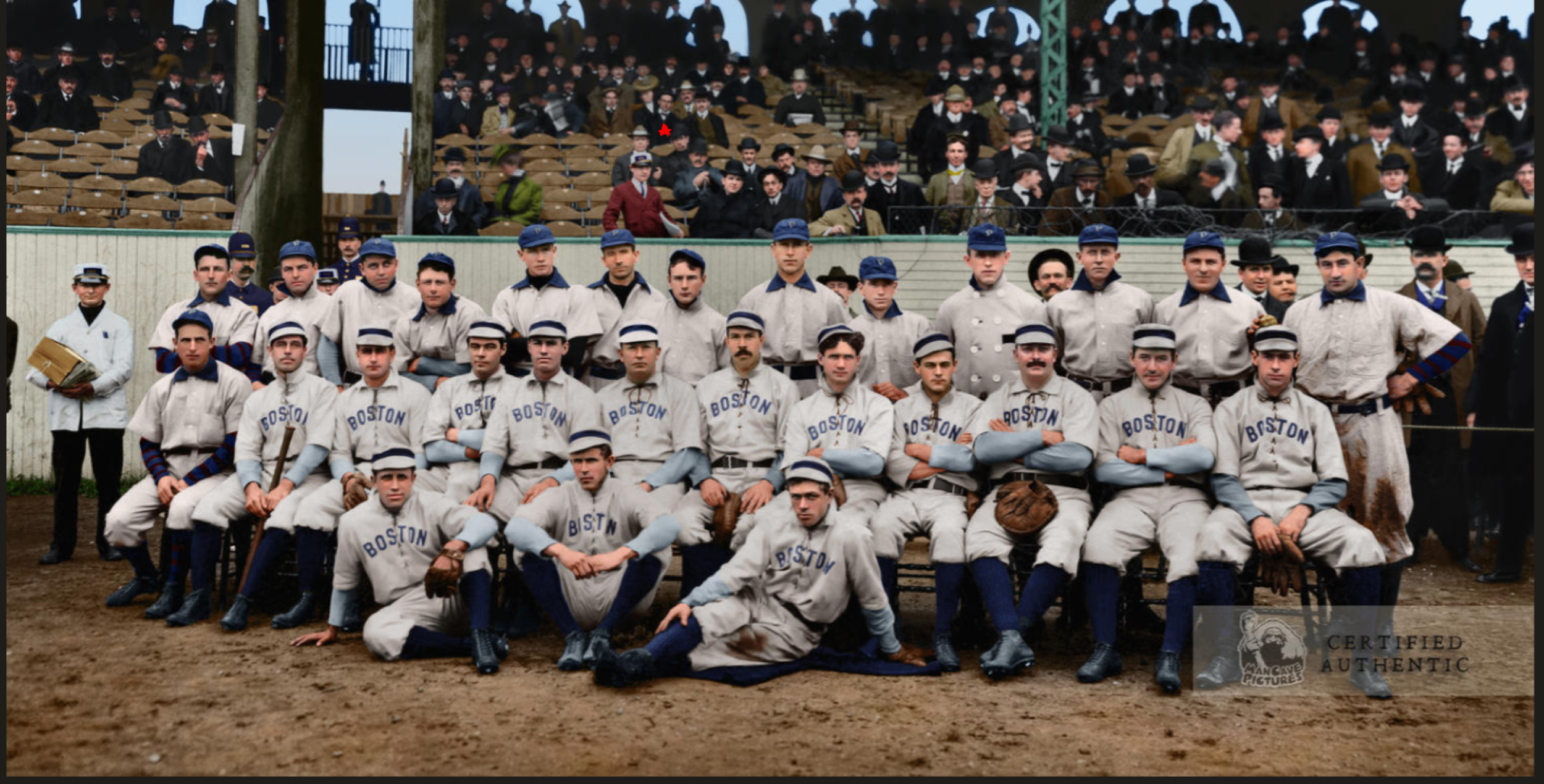
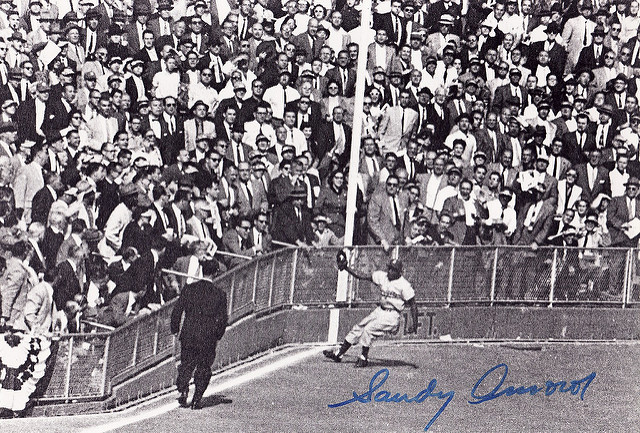
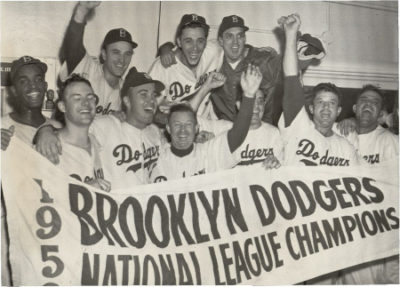
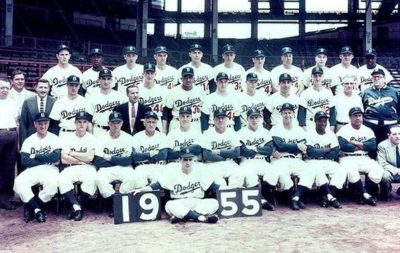
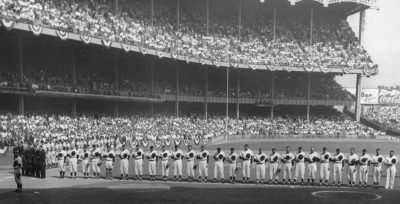
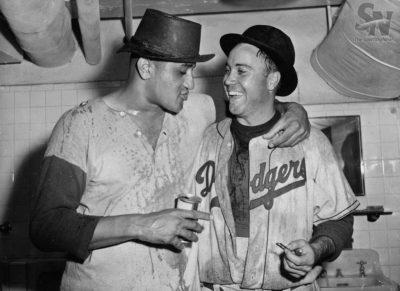
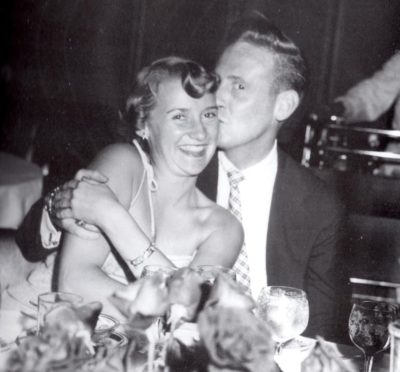
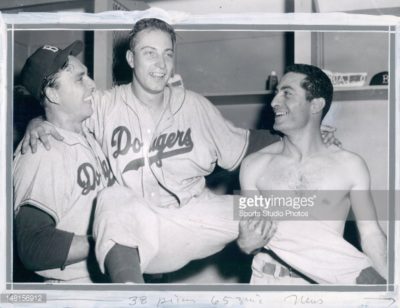
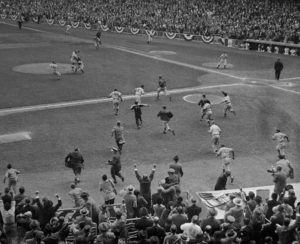
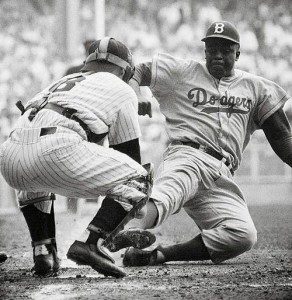
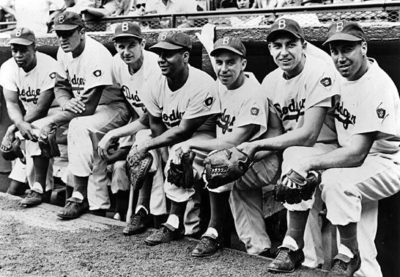
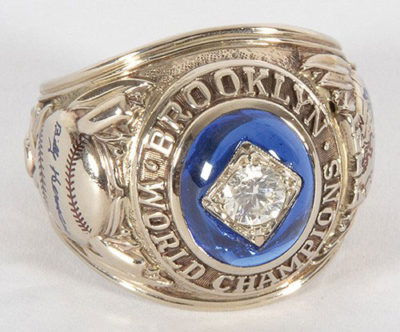
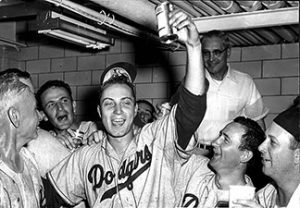
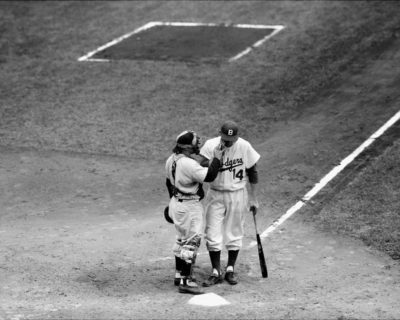
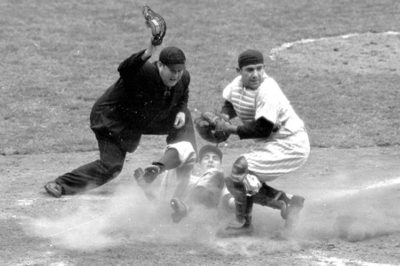
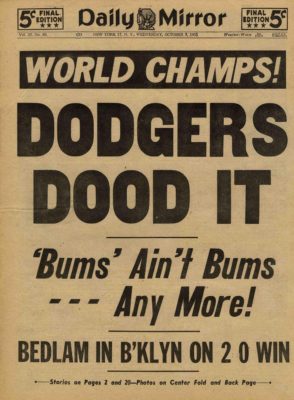
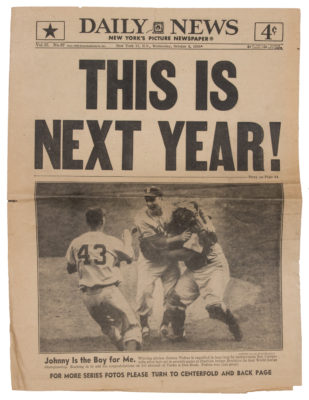
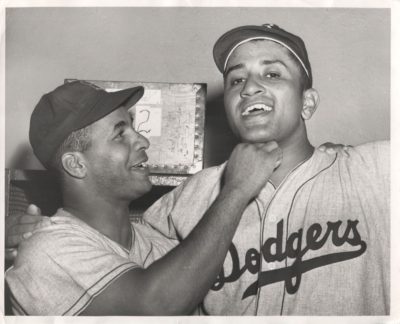
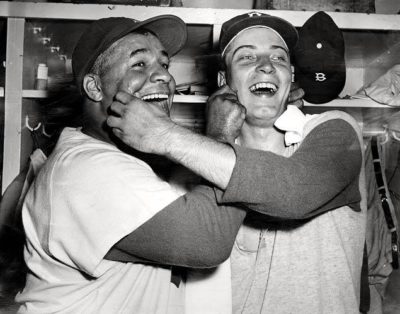
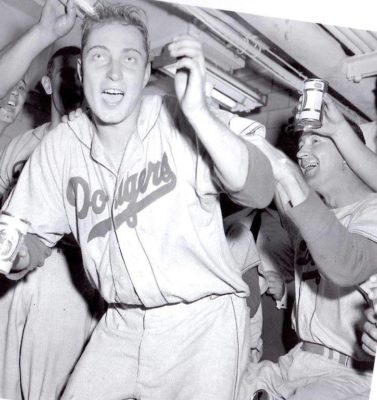
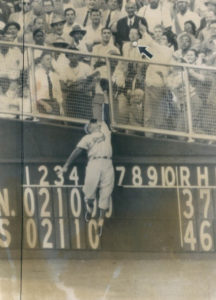
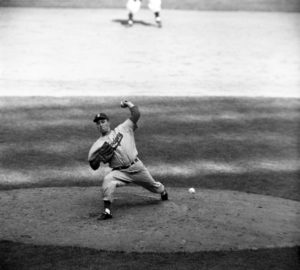
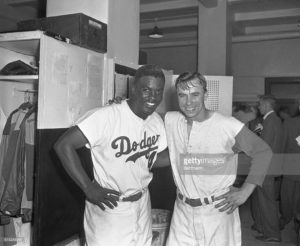
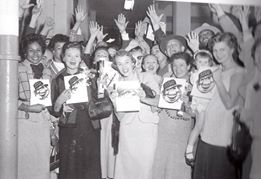
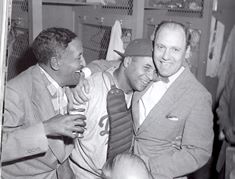
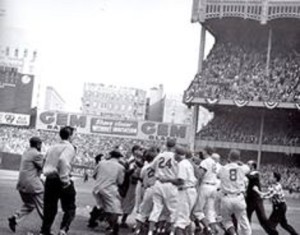
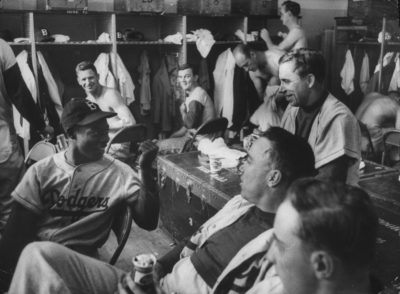
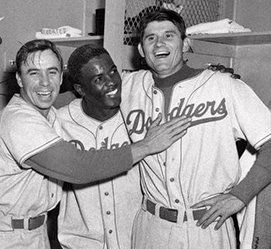
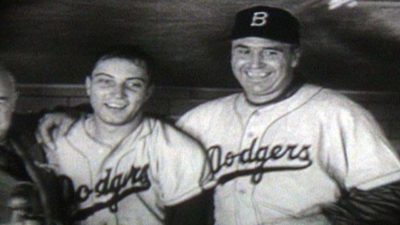
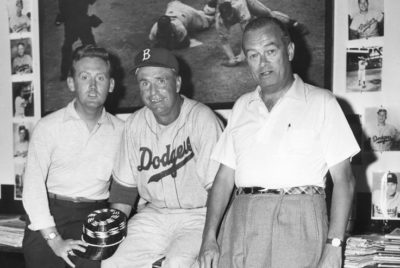

I agree with your pick. I was only a boy and we only had a television for 2 years but that play is seared in my brain for life. It cemented my mania for the Dodgers for life. In my lifetime there has never been such an iconic team in baseball as those “Boys of Summer” The 1988 world series pinch hit homer of Gibson also stands out and was more dramatic. However 1955 was the first and it was Podres 23rd birthday as I recall.
Johnny Podres had a great career and is often overlooked when great pitchers are discussed. Thanks for refreshing my memory and making my Christmas bright. Dennis Friedenbloom
OK, here we go, Professor Keedy. This is one magnificent essay! You flawlessly build to the “Catch” with just the right blend of background material combined with peerless prose, to the game saving play. And I love the Amoros quote placed just right as a nifty counterpoint. The catch is better than I remembered and Berra’s drive was more substantial than I thought. Never realized Sandy blasted a full 60 yards, with the left field stands so dangerously looming–and then the lefty whirling throw! A truly great play that preserved a way-over-due Brooklyn World Series victory.
But, not so fast, MK. I still contend Ron Swoboda’s grab was the best. Seemingly, anticipating the crack of the bat, Ron sprinted 55 feet out of nowhere, into right center field, executing a head-long dive, with his backhand glove so positioned as to snare Brooks Robinson’s sinking liner. Anything less than perfect timing on all counts and the ball is “down and through for extra bases” (as Dodger announcer Connie Desmond would say) and the Orioles are leading by a run in the 9th, with a runner in scoring position.
Tim Britton, staff writer for The Athletic, calculates the time of the play at 3.4 seconds with a catch probability of eight percent. As Michael has pointed out in a previous essay, if Baltimore wins that game, tying the Series at two games a piece, the Mets Shea magic would have been broken. And going back to Memorial Stadium against a loaded O’s club was something Gil Hodges’ Wunderkinds did not want to do.
The key was in Swoboda’s quote, “I wanted the ball.” This provided Ron a crucial mind set and “ball of energy” 100% geared to making the play. There was no room for error. Without this other worldly catch, the Metropolitans might have been just another over achieving baseball team and not The Miracle Mets of 1969.
Dr. Bill — ?
Having heaped praise on Swoboda’s dive-and-grab in nominating it for our all-time runner-up trophy, I’m somewhat loath to take issue with your commentary now. But! We might remember that if S. had opted to corral Robinson’s ball on one bounce, the very same run that scored from third after his acrobatics would have scored, but only that single, tying run. For both runners to have scored, the ball would have to get by Swoboda, and he increased the chances of that exponentially by choosing to go for broke rather than playing it safe. He’s at the pinnacle of our pantheon here when it comes to eye-rubbing catches; no doubt of that. (“Let’s see that again!”) But a hit in this situation would not have beaten the Mets in Game Four, and even if it had, the series would have been tied at that point.
By contrast, Amoros’s masterwork took place in Game Seven, as we all know. There was no tomorrow, for either team. If he failed to catch up to Berra’s drive, the Dodgers would have been looking at a tie ballgame, nobody out, and a runner in scoring position (probably on third base). They had already scored all the runs they were going to get.
This little study of ours has been pretty subjective, admittedly. When we started, with Bobby Richardson in tenth place, I said, “we should home in upon eye-popping catches made when the stakes could not have been higher. . .when virtually everything was riding on the result.” Those criteria define Amoros’s catch better than Swoboda’s, if only in my arguable opinion
All that said, I so much appreciate your high marks for the essay itself. As you said earlier, much of the fun is in the eternal debates these posts can inspire.
All best wishes,
Michael
Haha! Glad to see that my two contributors, Mr. Keedy and Mr. Schaefer are engaged in a nice friendly debate. That’s what it’s all about! Where would I be without these two guys??
Merry Christmas to you both!
And also, Merry Christmas to all our loyal readers! Thanks for all your loyal support over the year.
Gary
I’d like to add my “Merry Christmases” to our readers as well! We are all kindred spirits, perhaps more so than ever at this special time.
God bless Gary, Wilhelm, Dennis, Joan, and even those who might think we’re a little wacky over a glorious game as it was played when we were kids. (We probably are!)
Happy New Year!
Michael
Yes, Gary, we are the dynamic duo (ha, ha). But I hate to lose. So here’s another salvo. Can Keedy field it and throw me out rounding third and heading home?
First, Michael, it’s not like S. is coming IN on a line drive and playing it safe, on a hop. In that situation, the ball is fielded and not skipping past him for a game breaking extra base hit. On the Robinson drive, Ron is cutting across the field, at a right angle to the liner. If he slows to play it safe, he watches it skip past him rolling merrily through the right center alley.
It’s either catch or miss…catch scores one, miss is possibly the game “all the way to the wall.” How is Swoboda going stop a ball NOT in front of him by slowing and not diving? Another less likely scenario is that his glove is not positioned perfectly and the ball caroms off the leather, maybe far enough away to score the other run any way.
You’re right, not game 7. But going back to Maryland, all tied, would dramatically change everything. The superior team would be back home with a huge weight lifted. And the Mets couldn’t keep making impossible plays.
Finally, though this was huge in Brooklyn history and for their beleaguered fan base, the Dodgers were a perennial power poised to get over the hump to victory. The Mets were still downtrodden coming in to ’69. Their outcome was historically miraculous not more or less inevitable.
Hi Michael:
So, it was the A. Choice.
Sorry, guy but I’m with Bill on this one. Outcome, schmoutcome. Do you really think Swoboda calculated all the “what ifs” in his head before going for the catch? I’m sure every piston in his body was firing on one thing; catch the dang ball. There was no room for any other thought.
I also think Agee’s catches deserve individual slots on any “greatest” list. These catches were made from two different perspectives all the way right and backhanded and all the way left tumbling. (I think I remember that right.)
To condense them into one slot is a disservice to each of them. However, here’s what made our baseball so great. I am absolutely certain not one of these players considered how he could parlay it into a more lucrative bonus or a better contract while he was running his heart out to make the catch.
Have a wonderful holiday my friends. God bless you and yours and keep you all safe.
Joan
Good, Joan, nice perspective. Did you note that Agee’s catch to his left had Tommy tapping his glove before he made his warning track dive? This says he knew he had it. His first backhand snag near the wall, moving right, was probably the tougher catch.
Praise to Michael Keedy for an outstanding series on the 10 Greatest WS Catches-from Richardson to Amoros. We may have a friendly disagreement on the Number 1 but he brought an impressive insight to the Sandy A. World Series game saver. His speed, the amazing distance covered, the proximity of the wall and the marvelous throw to double up Gil McDougled–plus the significance of the play–puts Amoros in a lofty position.
Merry Christmas to all and thanks for joining us in these discussions!
Best, Bill
Enjoyed reading all the friendly debates regarding the “Best Catches”. A few weeks ago, when Mr. Keedy’s series began, I commented that Agee’s, Swoboda’s, and of course Amoros’ grab, had to be ranked among the best ever, IMHO. Also, not to be over-looked is Gionfrido’s catch of Joltin’ Joe’s smash {in the ’41 Fall Classic I think ?}. A note about Sandy Amoros : I still fondly recall Tommy Lasorda’s story of the ’55 Brooklyn team during his HOF induction speech in ’97; when he mentions Amoros…so funny {Google it if you don’t remember}. {Another note : In the close-up photo of the LF corner, notice LF line umpire Red Flaherty’s focus and perfect positioning to view fair/foul and catch/no catch} Merry Christmas and may all of us baseball rats continue posting in 2023; about our love for the greatest game !
Great point, Tom, on Flaherty’s focus. Will check out Lasorda’s speech. Gionfrido, in ’47, was covered by Dr. Keedy in his round-up, but the catch was much better than I thought.
Merry Christmas!
Hey Michael:
I should have thanked you for doing this series earlier. You write with such immediacy, you make us feel we are actually seeing he action as you describe it. Thanks again.
Sincerely,
Joan
Great series. I really enjoyed every one of the ten catch stories.
Just a final note about the ’55 Dodgers win. As a red hot ball fan in those days, rooting for the Giants, I just had a strong feeling something big was going to happen.
When Brooklyn lost the first two games at Yankee Stadium, I had a hunch they were going to sweep at Ebbets Field, then lose again at The Stadium, and then win the 7th game. So, with the Dodgers down two games to none I began making small bets with my class mates that the Dodgers would win the World Series.
One of the leaders of our class approached me and said, “Let me get a piece of you, Bill, while you’re still ripe. I’ll bet you two bucks the Yankees win.” I made nine bets on Brooklyn, six for $1 and three for $2, winning a grand total of $12. My greatest triumph at Westfield high school !
25 years later I won a lot more money sports betting. But, alas, the winning didn’t last.
Enjoy,
Bill
Thanks Bill…I believe you once filled us in on your sports betting history. Glad that’s all behind you!
Great article Bill.
Not only was your description of the Amoros’ catch excellent, but you did a great job putting the play it the proper historical perspective. It is hard to argue that this was number 1!
For those who have been following along with Michael Keedy’s Top Ten Greatest World Series Catches essays, we’re in the final stages of converting this series of essays into a self-published e-book. Hopefully, it’ll be out in the next six weeks or so. Will keep everyone posted. I’m serving as Michael’s editor for the project…but I told him if it becomes a best-seller, I’m taking credit for discovering him!
Hi Gary:
After reading your news about the e-book, I re-read the final installment on the greatest catches and the comments regarding the #1 pick. After this post, I promise I’ll say no more about it.
In addition to Bill’s and my comments about Ron Swoboda’s catch being superior to Amorose’s: after Tommy Agee’s two fantastic catches the day before, Ron Swoboda, whose fielding skills can best be described as adequate, made the catch that deserved every accolade written about it. Those Orioles in the dugout seeing it had to have thought they were playing a team of destiny. How else could you account for that level of play. As Tom Seaver said, “God is a Mets fan.” (At least in 1969 He was.) I think the Os knew they were beat after that, no matter how they tried. If my dad had lived to see it, I’m sure he would have said that catch knocked the stuffin’s out of them.
With that, I’ve had my last say on the matter.
Kind regards,
Joan
Thanks Joan…maybe Michael will have a response.
HI Gary:
Still chuckling over your response Can’t decide if your thanking me for the comment or my promise it’s the last one.
J.